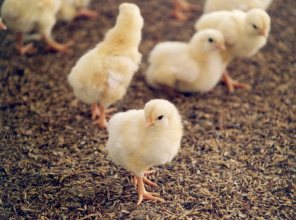Litter management – Part 1: Good litter for healthy birds

Chickens which are kept on floor systems are in permanent contact with the litter they live on. To a large extent this can have an impact on their performance. Quality control and management will help keeping it in good condition.
Litter is a very important product in poultry growing, because birds are exposed to the litter and its contents (microbes, moisture, ammonia, dust, odour, and texture) from the first day of life. Badly managed litter may facilitate the spread of certain infectious diseases, and also creates problems which lead to serious economic losses. The “litter problems” have not yet been classified or identified specifically, since they are connected with other management problems as well.
There are several types of litter commonly used in poultry houses such as pine shavings, hardwood shavings, pine or hardwood chips, rice hulls, peanut hulls, sand, crushed corn cobs, chopped straw, hay, or corn stover, and processed paper. These materials are usually used at rates ranging from 2-5 kg per square meter, and the choice of such materials should be made based on the relative advantages and disadvantages of each under particular farm conditions (Table 1).
Housing and management
Houses with concrete floors may be easier to clean, but those with earth floors are more difficult to handle and disinfection following removal of old wet litter may be an ineffective procedure, leaving infectious materials and debris. This will become a source of infection when new broods of chicks are placed in the house.
Some houses seem to have a continuous problem with wet litter. Poorly constructed houses, especially where roofs are not properly insulated, can lead to condensation which drips on the litter. Such a problem may also arise from worn nipples that have been used for five years or more. The timely replacement of worn nipples should, therefore, provide an opportunity for improving litter quality. Reductions in cake volumes of 50-90% are reported following replacement of worn nipples. Other management opportunities include pressure adjustment, proper line height, and routine flushing and line sanitation. When excessive caking develops under drinkers, it may be necessary to stir the litter or top it with fresh, dry bedding.
Temperature and humidity
Fans, not optimally numbered or located, or running at incorrect rates may allow poor gas exchange at certain points in the house. This helps water vapour to be absorbed into the litter or not to escape from it. Consequently, mould and bacterial growth is enhanced, particularly when the in-house temperature is high.
Poor ventilation, along with the high temperature and humidity, may also lead to ammonia build-up in the house. This may reach noxious levels which are unpleasant for attendants and the stock. In severe cases, ammonia build-up will contribute to various disease problems such as coccidiosis, breast blisters, ammonia burns, and respiratory infections.
5 Feed factors and litter

See also: Litter management – Part 2: Litter condition strongly depends on good management












